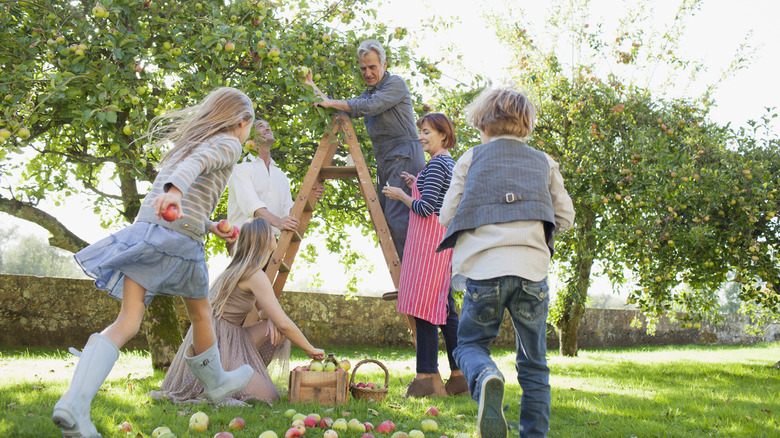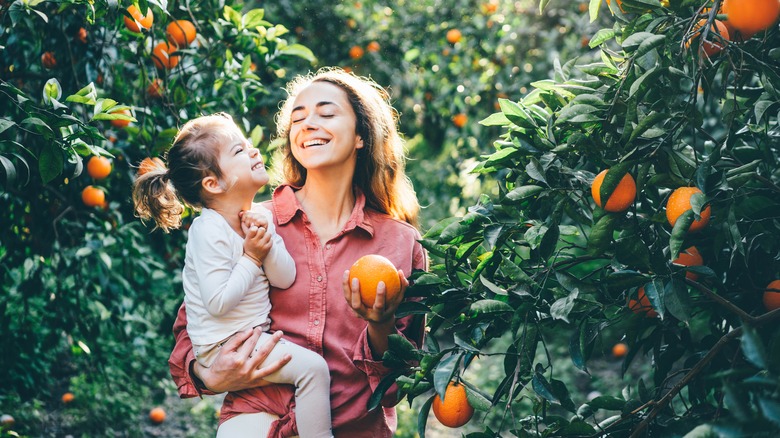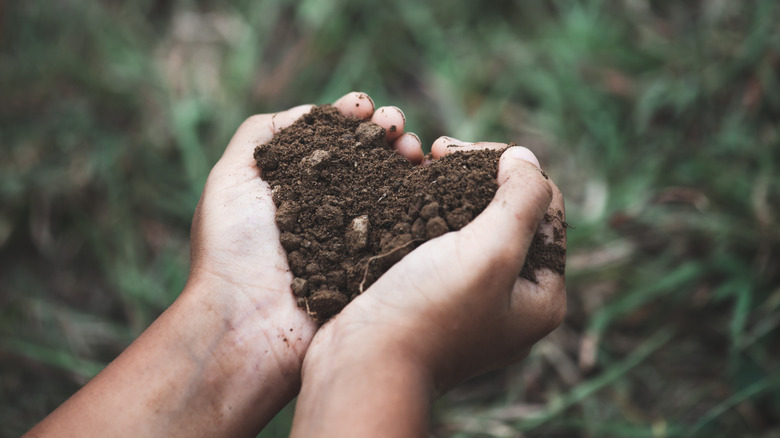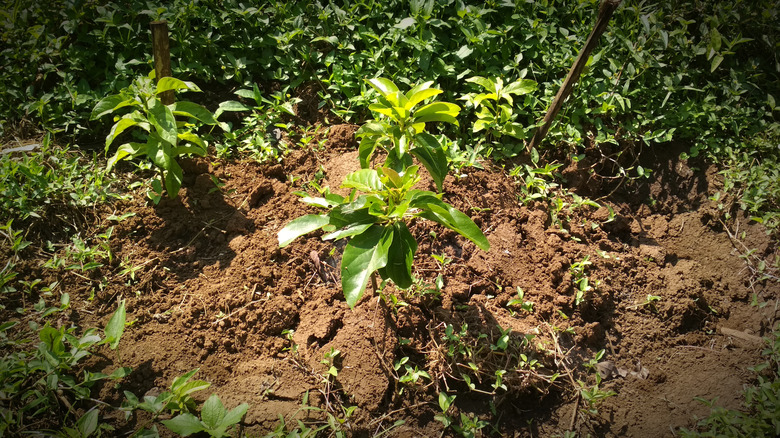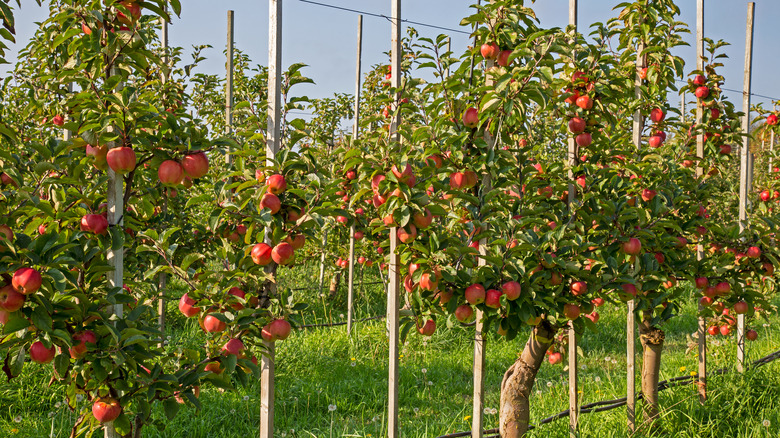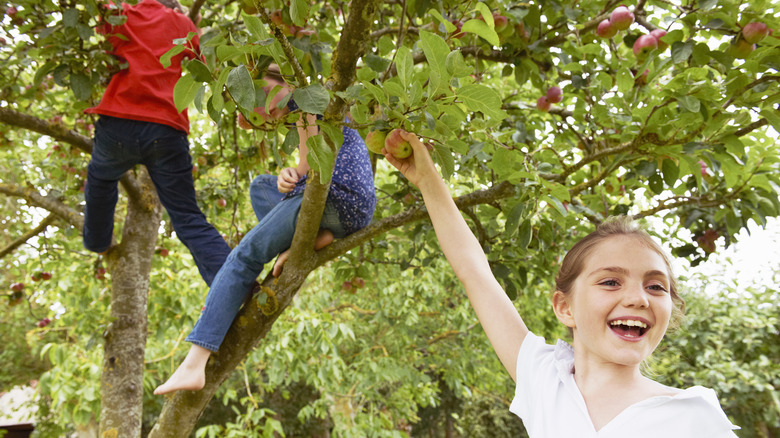How To Plan And Plant A Fruit Orchard In Your Yard
Whether you plan to spend your winters making jam or simply want to enjoy the taste of an apple picked straight from the tree, growing your own fruit is a rewarding occupation. Even a beginner gardener can enjoy the literal fruits of their labors by planting an orchard where the focus can be solely on tree-grown fruit like cherries, pears, and oranges, or it can be expanded to include berry bushes for an added touch of sweetness. The benefits don't stop at the bountiful harvest; The Orchard Project emphasizes that orchards encourage biodiversity, produce resilient long-living trees, and reduce negative impacts on the environment.
Unlike the starter vegetable plants commonly purchased for backyard gardens, some fruit trees take years to become established and bear fruit. In this way, planting an orchard can be thought of as a long-term project, and it's certainly one that calls for advanced planning. From stone fruit to citrus to figs and kiwis, fruit trees and shrubs each require specific care in the beginning, yet over time, they start to take care of themselves and do not need to be seeded, purchased, or planted each season.
A garden patch allows you to work with the land, but an orchard gives you a chance to truly become deeply rooted in your environment. They're also just lovely spaces to be around. As compensation for your hard work, you'll benefit from trees that will yield fruit for multiple generations.
Choose your fruits
Apples, oranges, avocados, berries — just because you can find something at your local big box store doesn't mean it'll fare well when planted in your yard. Research is sure to yield more satisfaction than impulse shopping! The most important considerations will be the climate of your area and space limitations within your yard. Look into specific varieties to figure out what will grow best in your location. For example, apple trees require certain numbers of chill hours (temperatures below 45 degrees Fahrenheit). If you live in Georgia and can't stand the sight of another peach, you'll be hard-pressed to successfully grow 'Fuji' apples instead. There are low chill cultivars, though, that can thrive as far south as Central Florida, per the University of Florida IFAS, so you might do well with an orchard full of 'TropicSweets.'
In regard to yard space, think ahead to the future result of what you wish to plant today. Baby trees are adorable, yet in a few years' time, they'll grow tall with widespread canopies. Similarly, raspberry bushes can grow 5 feet tall and wide, and certain varieties need to be planted as much as 100 feet away from each other, advises Stark Bro's. You can see how quickly your space needs multiply if you're not intentional with your choices. Also, think about water intake; it takes less than 50 gallons of water to produce 1 pound of strawberries, yet over 260 gallons for the same amount of plums (via HuffPost).
Select the best site and prepare the soil
You might have one sunny spot in your side yard, which is where the orchard is going to go no matter what. You may also have a few acres to survey and pick the best location. Penn State Extension explains that exposure to sun and wind will impact trees the most as winter turns to spring. The depth of usable soil (deeper is better) and the area's ability to drain excess water will have an effect on the health of your trees. Land that slopes keeps cold air from hovering, and elevated land naturally stays warmer because it receives more time in direct sunlight.
Once you've picked your ideal spot, optimizing the health of your soil is the next important step. For a major project like an orchard, it's advisable to take soil samples for testing. A local nursery or university extension program can help you understand the results, which will give you instructions on how to correct nutrient deficiencies depending on the requirements of your selected fruits. For instance, apricots and figs prefer slightly alkaline soil, but blueberries require an acidic pH level between 4.5 and 5.5, warns Michigan State University Extension. From what you learn about your soil, you'll know how to make everyone happy by using appropriate soil amendments. Better to do this before you begin planting.
Design the layout and plant your fruit trees
Fast-growing trees will create shade in a hot sunny backyard. Whether or not this is a good thing will depend upon what other crops you've chosen and, therefore, where they'll work best in your layout. Many fruits need a full day's sun to properly sweeten, yet plums, currants, and cherries will do fine in partial shade, per Gardeners' World Magazine. If you've opted for a blackberry bramble, finding enough space for it to spread will be of utmost importance. These are the kinds of things to take into account before digging any holes.
Other considerations on your list should be ease of watering and root depth. Will you be able to install an irrigation system or will everything need to be watered by the garden hose? Using a hose — even one with a sprinkler attachment — may indicate the need to situate your highest water-consuming plants closest to the source. In regard to root depth — because you're dealing with trees as opposed to shallow-rooted vegetables — take into account pre-existing structures around the property.
Container-grown trees and bushes can be purchased locally in the spring and planted as time allows. You can also order bare-root plants in the fall, which will be delivered to your door come springtime, but keep in mind that they will need to be planted in the ground immediately upon arrival, points out UC Master Gardeners.
Train and prune your fruit trees
Some fruit trees can be treated just as you would a new puppy: training from day one. Of course, with trees, this means proper maintenance instead of sit-and-stay commands. Clemson Cooperative Extension explains that the most successful trees are pruned to follow a central leader trunk as they grow, and this keeps the branches from becoming entangled and having difficulty producing fruit. Sometimes you'll manipulate the direction a branch grows in by tying it to another; other times, you'll completely remove them. Ultimately, the result will be a healthy fruit-bearing tree with fewer pest issues.
Fruit trees can also be trained along walls and fences, adds the Old Farmer's Almanac, and it's not entirely different for berries. You know that unwieldy sprawling bramble in your neighbor's yard now threatening to take over the entire street? The messy thicket could have been avoided if the shrub was trained from the start.
Perhaps you're excited about kiwis or grape varieties that thrive in your climate zone. If so, fencing is a must for vining fruit. You can take it a step further and use the fencerows to create an edible boundary wall for the entire orchard. Another possibility would be using a trellis or archway; these types of support structures also work for strawberries.
Maintain your orchard and harvest its bountiful fruit
An established orchard will require little tending, but to get it to that point, you'll inevitably need to perform regular maintenance. Your first line of defense will be choosing disease- and pest-resistant plant varieties at the start. Your second line of defense will be making sure the environment around your trees and shrubs naturally discourages potential issues. Simple steps include proper fertilization and watering techniques, clearing away debris and pruning dead or decaying branches, and planting ground cover plants between trees.
In the event that you need to resort to the use of herbicides and pesticides, try to rely on organic options that are naturally derived from plants and rocks if you can. As noted by Utah State University Extension, commercial pesticides can absolutely be used in safe ways; however, they may also leave harmful residue on fruits that should not be consumed. Furthermore, sometimes pesticides do more harm than good by killing insects that are actually beneficial.
At the end of the day, the point of planting and maintaining your own orchard is enjoying the delicious fruit it produces. Experiment with each plant to know when is the perfect time to harvest a piece for peak ripeness. Then sit back, smile, and indulge. You've earned it!
